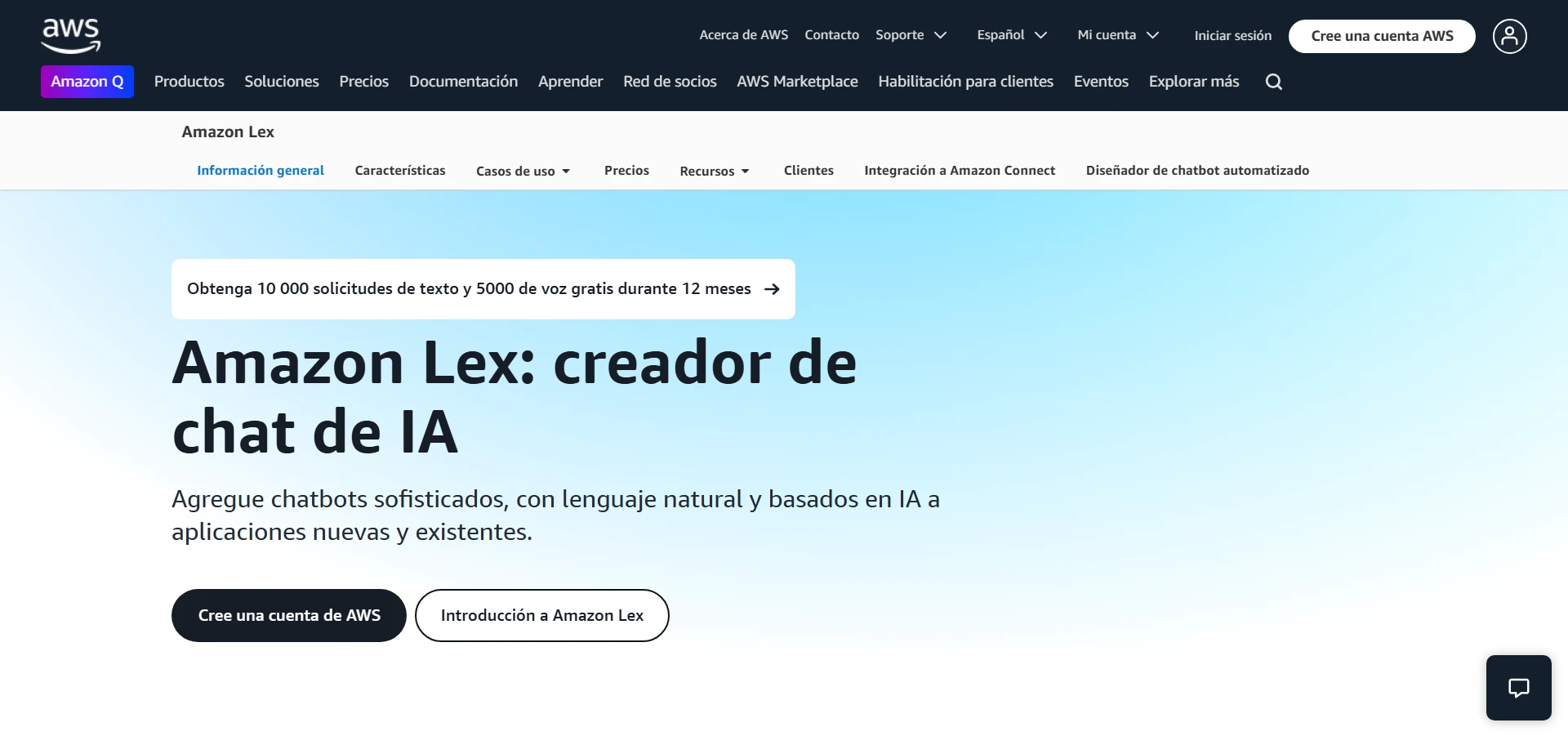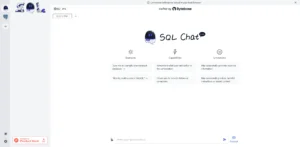Amazon Lex Artificial Intelligence Tool

DESCRIPTION
Amazon Lex is a sophisticated service offered by AWS that enables developers to build conversational interfaces using voice and text. By leveraging the same deep learning technologies that power Amazon Alexa, Lex allows the creation of chatbots and virtual assistants capable of understanding natural language inputs. This service simplifies the process of integrating conversational capabilities into applications without requiring extensive expertise in machine learning or natural language processing.
At its core, Amazon Lex uses automatic speech recognition (ASR) to convert spoken language into text and natural language understanding (NLU) to comprehend the intent behind the input. This combination enables the system to capture user intent and extract relevant information, facilitating dynamic and context-aware interactions. Developers can define intents, slots, and dialog flows to customize how the bot responds and manages conversations, tailoring it to specific business needs.
One of the key advantages of Amazon Lex is its seamless integration with other AWS services such as Lambda, CloudWatch, and Cognito, which enhances the bot’s functionality and security. For instance, Lambda functions can be triggered to execute backend logic or fetch information during a conversation, enabling real-time responses and personalized experiences. Additionally, Amazon Lex supports multi-turn conversations, allowing the bot to maintain context and manage complex dialogues over multiple interactions.
Amazon Lex is designed to be highly scalable and cost-effective, making it suitable for a wide range of applications from customer support to IoT device control. Its pay-as-you-go pricing model means businesses only pay for what they use, without upfront commitments. By providing a robust framework for conversational AI, Amazon Lex empowers organizations to engage customers more effectively through natural and intuitive dialogue interfaces.
Why Choose Amazon Lex for Your Project?
Amazon Lex offers advanced natural language understanding capabilities powered by the same technology behind Alexa, enabling developers to build conversational interfaces with remarkable accuracy. Its seamless integration with AWS services such as Lambda and DynamoDB facilitates efficient backend operations and data management. Lex supports multi-turn conversations, allowing for sophisticated dialogue flows that enhance user experience. Additionally, the service provides automatic speech recognition (ASR) and text-to-speech (TTS), enabling both voice and text interactions without requiring external tools.
Practical applications of Amazon Lex include creating intelligent chatbots for customer support, automating appointment scheduling, and developing interactive voice response (IVR) systems. Retailers can leverage Lex to guide shoppers through product selections, while enterprises use it to streamline internal workflows by automating routine inquiries. Its pay-as-you-go pricing model ensures cost-effectiveness for projects of varying scales, making it a versatile choice for businesses aiming to implement conversational AI efficiently.
USE CASES
- Customer Support Automation: Amazon Lex can be used to build intelligent chatbots that handle common customer inquiries, such as order tracking or account management. For example, an e-commerce company can deploy a Lex-powered bot that allows users to check their order status, initiate returns, or get product information through natural language conversations.
- Healthcare Appointment Scheduling: Medical providers can use Amazon Lex to create virtual assistants that help patients book, reschedule, or cancel appointments without human intervention. For instance, a clinic can implement a Lex bot that interacts with patients via voice or text to find available time slots and confirm their appointments.
- Banking and Financial Services: Financial institutions can leverage Amazon Lex to offer conversational banking experiences, such as checking account balances, transferring funds, or reporting lost cards. A bank could deploy a Lex chatbot that securely authenticates customers and provides real-time updates on their transactions or helps with fraud alerts.
- Human Resources and Employee Self-Service: Companies can use Amazon Lex to streamline HR processes by enabling employees to request time off, check benefits, or update personal information via a conversational interface. For example, an enterprise could implement a Lex bot integrated with their HR systems that guides employees through leave application workflows.
- Travel and Hospitality Booking Assistance: Travel agencies and hotels can utilize Amazon Lex to create virtual travel assistants that help customers search for flights, book hotel rooms, or get itinerary details. A hotel chain might use a Lex chatbot to handle guest inquiries about room availability, amenities, and check-in/check-out procedures 24/7.
INTEGRATIONS
- Amazon Connect – Integrates Lex chatbots into contact center workflows, enabling natural language interactions for customer support and automating common inquiries.
- AWS Lambda – Allows Lex to trigger serverless functions for backend logic execution, enabling dynamic responses and integration with other AWS services or databases.
- Facebook Messenger – Supports deployment of Lex-powered chatbots on Facebook Messenger, providing conversational interfaces on a popular social media platform.
- Slack – Enables Lex bots to interact within Slack channels, facilitating internal team communications, automated workflows, and support via conversational agents.
- Amazon CloudWatch – Integrates with Lex for monitoring, logging, and analyzing chatbot performance and user interactions, helping improve bot accuracy and user experience.
PRICING MODEL
Amazon Lex employs a pay-per-use pricing model, which charges customers based on the number of text or speech requests processed. The service offers a free tier allowing up to 10,000 text requests and 5,000 speech requests per month for the first year, enabling developers to experiment without initial costs. Beyond the free tier, pricing is tiered, with text requests billed per 1,000 requests and speech requests at a slightly higher rate due to audio processing. This flexible, usage-based pricing allows businesses to scale costs directly with their application demand, avoiding upfront subscription fees.
Compared to alternatives like Google Dialogflow or Microsoft Azure Bot Service, Amazon Lex’s value proposition lies in its deep integration with the AWS ecosystem, facilitating seamless access to other AWS services and infrastructure. While competitors may offer similar freemium models or subscription plans, Lex’s pay-per-use approach provides cost efficiency for variable workloads, especially for users already invested in AWS. However, businesses seeking flat-rate pricing might prefer subscription-based alternatives for predictable budgeting.
How to Start Using Amazon Lex?
- Sign in to the AWS Management Console and navigate to the Amazon Lex service.
- Create a new bot by selecting the option to build from scratch or use a predefined template.
- Define the intents that your bot will recognize and specify sample utterances for each intent.
- Configure the slot types and prompts to gather necessary information from users during conversations.
- Test your chatbot within the console and then deploy it to your preferred platform or application.
PROS & CONS
-
 Amazon Lex enables developers to build conversational interfaces with automatic speech recognition and natural language understanding.
Amazon Lex enables developers to build conversational interfaces with automatic speech recognition and natural language understanding. -
 It seamlessly integrates with AWS services, facilitating scalable and secure chatbot deployments.
It seamlessly integrates with AWS services, facilitating scalable and secure chatbot deployments. -
 Users benefit from its cost-effective pay-as-you-go pricing model, reducing upfront expenses.
Users benefit from its cost-effective pay-as-you-go pricing model, reducing upfront expenses. -
 The platform supports multi-turn conversations, allowing for more natural and engaging user interactions.
The platform supports multi-turn conversations, allowing for more natural and engaging user interactions. -
 Amazon Lex provides built-in tools for easy testing and monitoring, streamlining the development process.
Amazon Lex provides built-in tools for easy testing and monitoring, streamlining the development process. -
 Integration complexities may arise when connecting Amazon Lex with non-AWS services, potentially increasing development time.
Integration complexities may arise when connecting Amazon Lex with non-AWS services, potentially increasing development time. -
 The platform’s pricing model can become costly for applications with high volumes of interactions, impacting budget management.
The platform’s pricing model can become costly for applications with high volumes of interactions, impacting budget management. -
 Customization options are somewhat limited compared to open-source alternatives, which might restrict highly specialized use cases.
Customization options are somewhat limited compared to open-source alternatives, which might restrict highly specialized use cases. -
 Latency issues can occur in regions where AWS data centers are less prevalent, affecting real-time responsiveness.
Latency issues can occur in regions where AWS data centers are less prevalent, affecting real-time responsiveness. -
 Documentation and community support are less extensive than some competitors, making troubleshooting more challenging for new users.
Documentation and community support are less extensive than some competitors, making troubleshooting more challenging for new users.
USAGE RECOMMENDATIONS
- Begin by clearly defining the purpose and scope of your chatbot to ensure focused interactions.
- Utilize Amazon Lex’s built-in slot types to simplify data collection from users.
- Incorporate Lambda functions to handle complex business logic and validations within your chatbot flow.
- Test your bot thoroughly in the Amazon Lex console before deploying it to production environments.
- Leverage multi-turn conversations to create more natural and engaging user experiences.
- Regularly update your bot’s intents and utterances based on user interaction analytics.
- Use versioning and aliases to manage different stages of your bot’s development and deployment.
- Optimize slot elicitation prompts to guide users smoothly through the conversation.
- Integrate Amazon Lex with other AWS services such as Amazon Connect or AWS Lambda for enhanced functionality.
- Monitor your bot’s performance using CloudWatch metrics to identify and resolve issues promptly.
SEE ALL ARTIFICIAL INTELLIGENCE TOOLS IN Chatbot
SIMILAR TOOLS

Cortana
It is a virtual assistant developed by Microsoft, designed to facilitate user interaction with their devices through voice and text commands. Since its launch in 2014, it has evolved to…

SQL Chat
SQL Chat is an innovative artificial intelligence tool designed to streamline database management and enhance user interactions with SQL queries. This tool allows users, regardless of their technical expertise, to…

ChatGPT.js
ChatGPT.js is an innovative artificial intelligence tool designed to facilitate seamless interaction between users and the powerful language model known as ChatGPT. Built in JavaScript, it provides developers with an…

Kuki.ai
Kuki.ai is an advanced artificial intelligence chatbot designed to engage users in natural and meaningful conversations. Built on sophisticated natural language processing algorithms, Kuki can understand context, maintain the flow…


